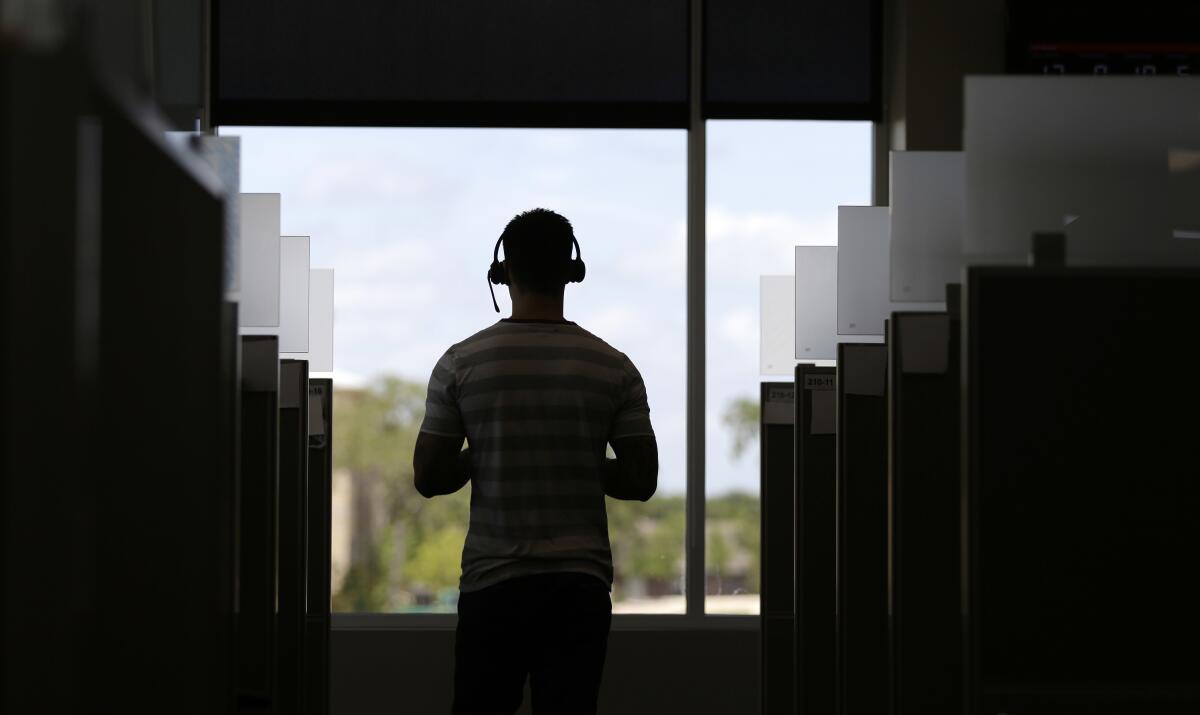Column: Some companies think customers are OK with lousy service. Think again

- Share via
Joan Cuadra’s 100-year-old mother wears a panic button around her neck in case she ever gets into trouble in her Westchester home.
Ideally, you push the button on the device and within seconds an operator will be heard from a speaker installed in the house — think OnStar, but for seniors or other people with medical issues.
“We decided to test it out,” Cuadra, 70, told me. “So we pressed the button. It took about five minutes for a service representative to respond — five minutes!”
For a 100-year-old woman who may have had a serious fall or heart attack, five minutes can be a life-or-death matter.
Cuadra asked the rep why it took so long to get on the line.
“She said that because of COVID, they don’t have enough operators to pick up all the calls.”
I’m sharing this anecdote not to kick dirt into the picnic of this particular service provider, Medical Alert, a subsidiary of Pennsylvania-based Connect America. Cuadra’s family pays nearly $360 a year for the company’s emergency service.
Rather, the explanation offered by the Medical Alert rep illustrates a problem that was an issue before the pandemic and is now exponentially worse as staffing shortages affect operations across most industries.
Customer service that comes up short.
I reported recently about the pandemic-related rise of recordings from businesses about “unusually heavy call volume” and epic waits on hold.
Case in point: Delta Air Lines saying last week that it’s been swamped with “a record-breaking level of calls” from travelers eager to fly again. Some passengers reported waits on hold as long as nine hours.
“We know you expect more from Delta and assure you that these challenges are temporary,” the company’s chief executive, Ed Bastian, said in a statement.
Generally speaking, experts told me, call volume across most industries is little changed from before COVID-19 upended all our lives. What’s different now is that there aren’t enough call center agents to handle customer requests for help.
Mark Rollag, president of xtDirect, an Omaha call center company with operations worldwide, estimated there were about 25% fewer agents answering phones last fall than before the pandemic because of cutbacks, staffers quitting and a lack of resources for people to work from home.
That was here in the United States. Overseas, in call-center-heavy countries such as India and the Philippines, entire facilities were shut down because of COVID-19. Some have reopened. Others have not.
It’s a problem all businesses need to address — or face the wrath of increasingly frustrated customers.
A survey released last week underlines that consumers are tired of being pushed around or kept at arm’s length when they have problems with a product or service.
The survey of 1,000 U.S. adults by TCN, a provider of cloud-based call center technology, found that Americans are “willing to wait on hold for six minutes on average, but the average actual wait time is three times longer, averaging 17.4 minutes.”
Moreover, most people “overwhelmingly prefer to interact with a live person when dealing with customer service centers,” meaning consumers despise those god-awful automated switchboards beloved by penny-pinching businesses.
“The results clearly show that, despite the ubiquity of technology in our daily lives and the automation of many business processes, you can’t take people out of customer service,” said McKay Bird, TCN’s chief marketing officer.
While the average wait time on hold is just over 17 minutes, about a quarter of survey respondents said they’ve been stuck on hold for 30 minutes or longer.
Perhaps the least surprising finding is that people really hate having their time wasted by customer service systems that make you wait forever on hold and then, after all that, suddenly disconnect you.
More than two-thirds of survey respondents cited this as their main beef when it comes to dealing with call centers. A slightly smaller percentage said they were cheesed by companies that bounce you around to different service reps to get a problem resolved.
Connect America, parent of Medical Alert, was understandably troubled when I shared Cuadra’s experience with her mom’s panic button.
John Brady, the company’s chief operating officer, told me that, contrary to the service rep’s COVID-related explanation to Cuadra, “our service, quality and ability to respond within seconds has not been impacted by the pandemic.”
In this case, he said, the delay in responding to Cuadra’s emergency call was “a technological issue.”
Most calls to his company are answered within 40 seconds, Brady said. “This call absolutely was not answered in that time frame.”
He blamed the cable phone service used by Cuadra’s mom. He said Medical Alert will, at no additional cost, provide her with a cellular-based system for any future calls.
That’s not to say the explanation the operator gave Cuadra was totally off base. Connect America, like all other call center operators, hasn’t had an easy time during the pandemic.
“Is it a challenge hiring and staffing call centers right now? Yes, it is,” Brady acknowledged.
When the pandemic eventually subsides, all companies should seriously rethink their approach to meeting customer needs.
If you’re a business that deals with consumers, you need to be sufficiently staffed to manage customer issues. That means hiring enough service reps — and providing adequate training — to handle calls in a reasonable time frame.
It also means earning people’s trust by making it relatively smooth and easy to reach a human being, if the customer so chooses, and not relying so heavily on automated systems that may save a few bucks but do nothing to build goodwill.
Yes, good customer service is expensive. A 2017 study by IBM found that businesses spend about $1.3 trillion a year on customer service calls.
But I suspect most companies will find it much more expensive to have exasperated customers take their business elsewhere.
More to Read
Inside the business of entertainment
The Wide Shot brings you news, analysis and insights on everything from streaming wars to production — and what it all means for the future.
You may occasionally receive promotional content from the Los Angeles Times.











